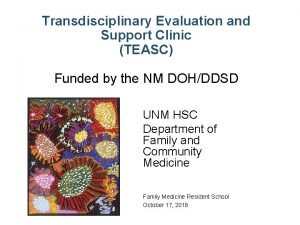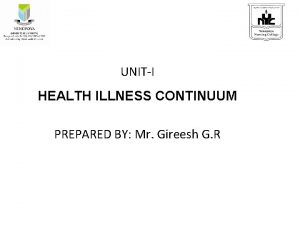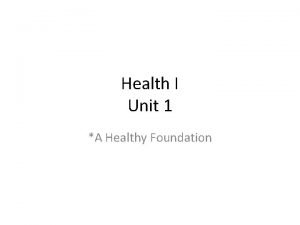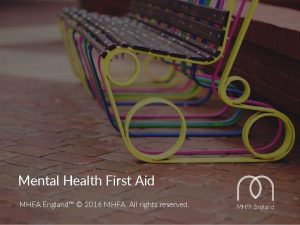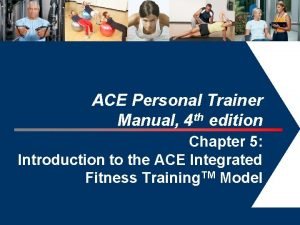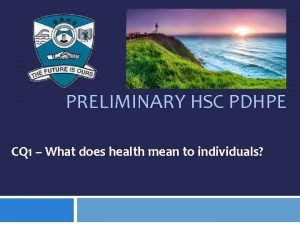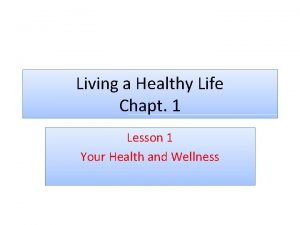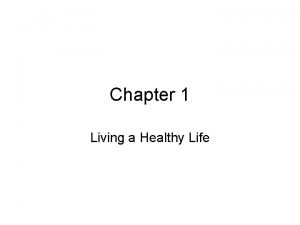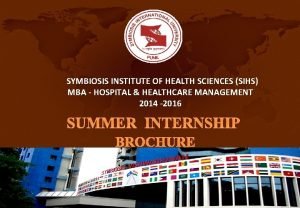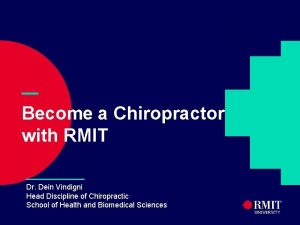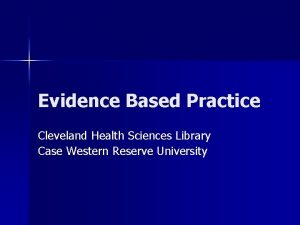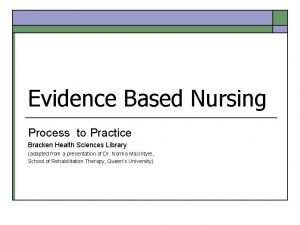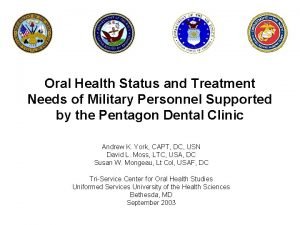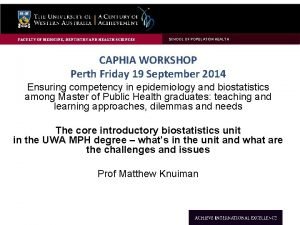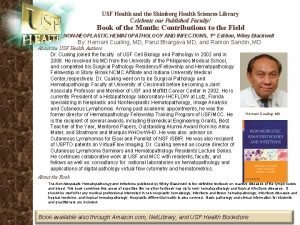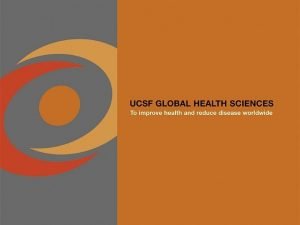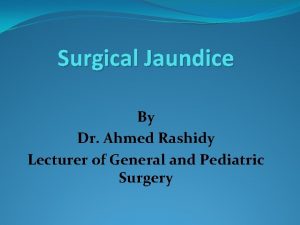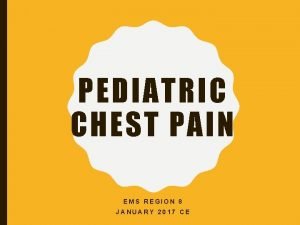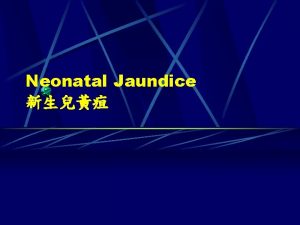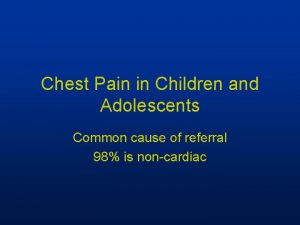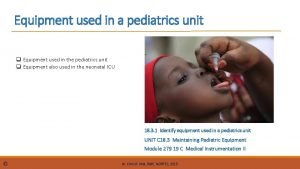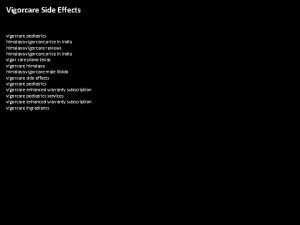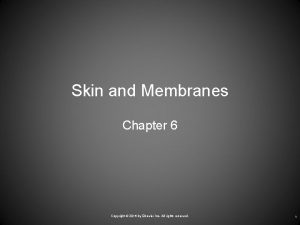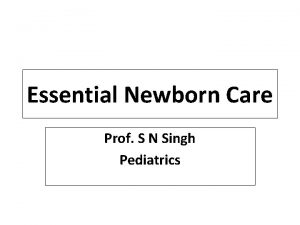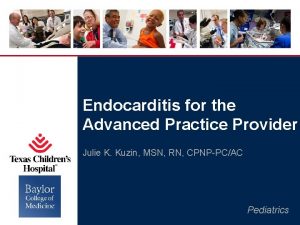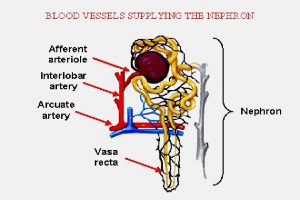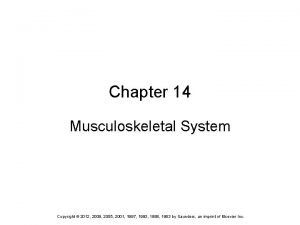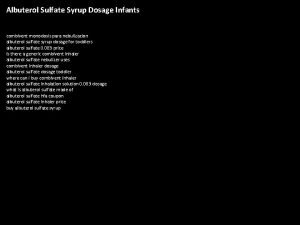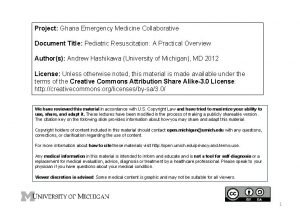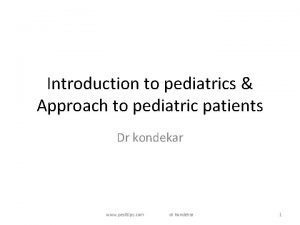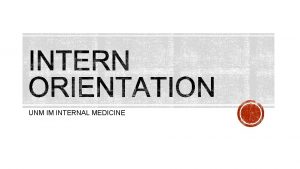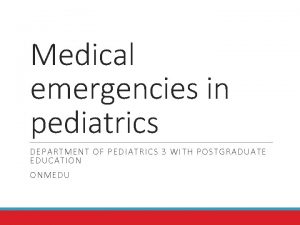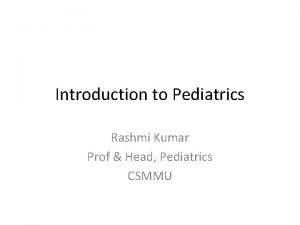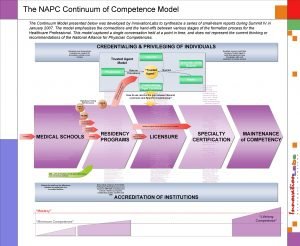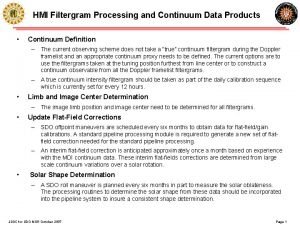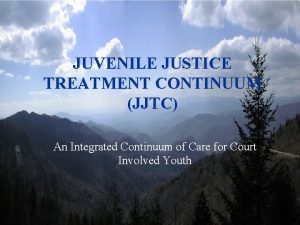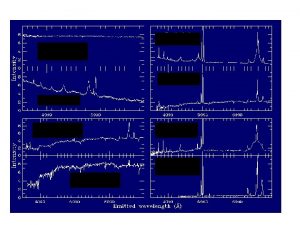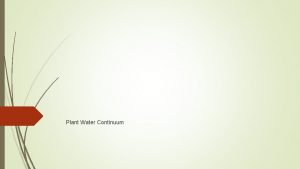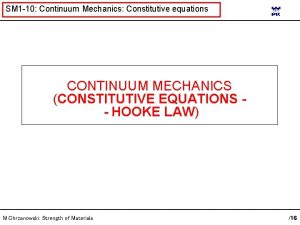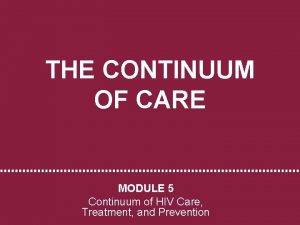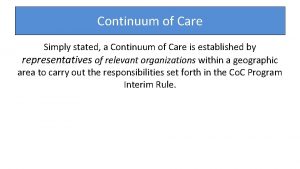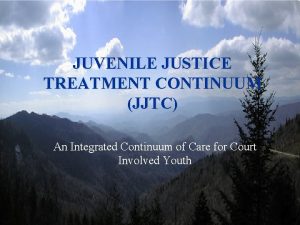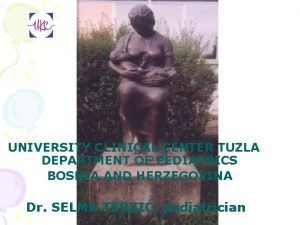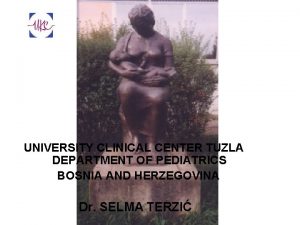UNM Health Sciences Center Department of Pediatrics Continuum

































































- Slides: 65

ﻣﺒﺎﻧی پیﺸگیﺮی ﺯﺧﻢ ﻓﺸﺎﺭ ﻭ ﻣﺮﺍﻗﺒﺖ ﺍﺯ ﺯﺧﻢ UNM- Health Sciences Center Department of Pediatrics Continuum of Care Vera Asplund, BSN, RN September 9, 2014


ﺍﺻﻄﻼﺣﺎﺕ • Induration: Tissue firmness that may occur around a wound margin • Erythema: An inflammatory redness of the skin due to engorged capillaries • Maceration: Softening of a tissue by soaking until the connective tissue fibers are so weakened that the tissue components can be teased apart

ﺍﺻﻄﻼﺣﺎﺕ • Undermining: a tunneling effect or pocket occurring under the pressure ulcer edges or margins • Slough: Nonviable tissue is loosely attached and characterized by string-like, moist, necrotic debris; yellow, green, or gray in color

ﺍﺻﻄﻼﺣﺎﺕ • Eschar: Nonviable (dead) wound tissue characterized by a leathery, black crust covering an underlying necrotic process • Granulation: Formation in wounds of soft, pink, fleshy projections consisting of new capillaries surrounded by fibrous collagen

ﻣﺮﺣﻠﻪ یک ﺯﺧﻢ ﺑﺴﺘﺮ • Intact skin with non-blanchable redness of a localized area • may be difficult to detect in a patient with darkly pigmented skin tones — Assess the surrounding area to observe differences in skin color • Also assess the area for: • Pain • Warmth or coolness • Firmness or softness as compared with adjacent tissue

Stage I

Treatment: Stage I • Remove the pressure • Do not rub or massage prominence • Do not use donuts • Protect from moisture • Monitor • No dressings required • Treat pain if present

Stage II Pressure Ulcer • Partial-thickness loss of dermis where you can see a shallow open ulcer with a red/pink wound bed, without slough • May also present as an intact or open/ruptured serum filled blister • NOTE: skin tears, tape burns, peri-area dermatitis, maceration should NOT be classified as stage II

Stage II

Treatment: Stage II • Remove pressure • Keep clean • Keep blister intact if possible • Cover with light dressing if ulcer is open • Example: non-adherent gauze dressing changed every day

Stage III Pressure Ulcer • Full-thickness tissue loss; subcutaneous fat may be visable but bone, tendon, or muscle are not exposed • Slough may be present • May include undermining and tunneling under intact skin

Stage III

Treatment: Stage III • Remove pressure • Eliminate slough • Autolytic, enzymatic or sharp debridement • Manage exudate • Foam, alginate • Monitor for infection • Treat pain

Stage IV Pressure Ulcer • Full-thickness tissue loss with exposed bone, tendon, or muscle • Slough & eschar may be present on some parts of the wound bed • Often undermining and tunneling is present • Exposed bone/tendon is visible or directly palpable

Stage IV

Stage IV

Treatment: Stage IV • Remove pressure • Eliminate slough or eschar • Manage exudate • Treat pain • Monitor for infection • Osteomyelitis • Septicemia • Cellulitis • Abscess

Unstageable Pressure Ulcer • Full thickness tissue loss in which the base of the ulcer is covered by slough (yellow, tan, gray, green or brown) and/or eschar (tan, brown or black) in the wound bed • Note: Until enough slough and/or eschar is removed to expose the base of the wound, the true depth, and therefore stage, cannot be determined

Unstageable

Treatment: Unstageable • Remove pressure • Eliminate slough and/or eschar • Hydrogel application to soften, sharp debridement • Never debride dry, stable, non-fluctuant heel ulcer • Restage once all slough and/or eschar has been removed • Manage exudate • Monitor for infection • Treat pain

Deep Tissue Injury • Purple or maroon localized area of discolored intact skin or blood-filled blister due to damage of underlying soft tissue from pressure and/or shear • Evolution may include a thin blister over a dark wound bed

Deep Tissue Injury

Treatment: Deep Tissue Injury • Remove pressure • Monitor for opening of wound • Treat pain • Protect from moisture

Staging • Pressure ulcers are NOT restaged at each assessment. They are staged only once unless a deeper layer of tissue becomes exposed

Dressing Types • Gauze • Limited role in modern wound care • Good for infected wounds that require frequent dressing changes • Not effective to promote moist wound healing

Dressing Types • Transparent Films • Allow O 2 to penetrate wound and release wound moisture • Helps with autolytic debridement • Good for partial thickness wounds stage I & II • Not suitable for heavy draining wounds

Dressing Types • Foam • Non-occlusive dressing • Highly absorbent • Less frequent dressing changes—up to 7 days • Use on draining stage II-IV • Don’t use on dry wounds

Dressing Types • Hydrocolloids • Contain gelatin or pectin that swells with exudate • Waterproof—helps with autolytic debridement • Use on shallow stage II pressure ulcers • Can trap moisture under the dressing causing maceration • Particles of the dressing can become lodged in the wound bed

Dressing Types • Hydrogel • Viscous amorphous gels • Applied to base of the wound to soften eschar • Use in wounds that are dry, contain hard eschar • Provide some soothing, pain relieving properties • Consists mostly of hypertonic saline • Require secondary dressing

Dressing Types • Alginates • Seaweed based woven fibers form a gel like material when they come in contact with exudate • Highly absorbent • Can be left in wound bed for several days • Require a secondary dressing • Good on highly draining stage III and IV ulcer • Can break into pieces left in wound and shouldn’t be used on dry wounds

Silver • Historically antimicrobial • Currently being put into many wound care products • Not effective in eliminating bioburden • Can stain the skin • Difficult to get insurance to pay

Honey • Medical grade honey • Promotes moist wound healing • Supports autolytic debridement • Helps to lower p. H of a wound which can increase healing

Assessing Complications • Complications can delay healing and may become life-threatening • All pressure ulcers are colonized with bacteria • Debridement and adequate cleansing prevent the ulcer from becoming infected in most cases • Swab cultures of the wound surface should not be used to identify infecting organisms

Assessing Complications • Ulcer infection • Is recognized by the classic signs of redness, fever, pain and edema • The cardinal sign is advancing cellulitis • Sepsis • May originate from infected pressure ulcers of any stage • Blood culture is the only way to identify the pathogen

Assessing Complications • Osteomyelitis (infection involving the bone) • Is likely in stage IV ulcers • Delays healing, causes extensive tissue damage, and is associated with a high mortality rate • A bone biopsy and culture are necessary for diagnosis • If the patient’s white blood cell count, erythrocyte sedimentation rate, and plain Xray are all positive, osteomyelitis is likely

Prevention • Nutritional management • Managing pressure • Skin care • Monitoring changes in risk status

Nutritional Management • The nutritional goal is a diet containing adequate nutrients to maintain tissue integrity • Monitor for signs of vitamin and mineral deficiencies—provide a daily high-potency vitamin and mineral supplement • Supplement or support the intake of protein and calories—healthy adults need one to two 3 -ounce servings of meat, milk, cheese or eggs each day; a malnourished patient may require as much as 2 grams of protein per kilogram of body weight daily

Manage Pressure • Pressure management entails the awareness of proper body positioning, recognizing the importance of turning and repositioning , and choosing suitable support surfaces for sleeping and sitting

Body Positioning • In Bed • Do not position an individual on skin that is already reddened by pressure • Donut-shaped products reduce the blood flow to an even wider area of tissue • Pillow placement and bridging can help reduce pressure • Do not place an individual directly on the greater trochanter • Heels should be suspended to avoid pressure • The head of the bed should be raised as little as possible (no more than 30˚)

Turning and Repositioning • Healthy people change position as frequently as every 15 minutes • Those unable to reposition themselves should be repositioned frequently enough to allow any reddened areas of skin to recover from pressure • Repositioning should happen at least every 2 hours while in bed and at least every hour when in a wheelchair • Never sit on personal items such as keys, pens, phone, etc.

Turning and Repositioning • To avoid effects of friction and shear forces • Lift rather than drag individuals across the bed surface • Have the individuals wear socks and long sleeves to protect heels and elbows

Turning and Repositioning • Sitting—carries the greatest risk of pressure ulcers. • Good body posture and alignment helps minimize the pressure on susceptible surfaces • Thighs should be horizontal so the weight is evenly distributed • If the knees are higher than the hips, body weight concentrates on the ischial tuberosities • Adequate support of the ankles, elbows, forearms, and wrist in a neutral position reduces risk • Separate knees so they do not rub together

Support Surfaces • Using pillows to bridge vulnerable areas is an effective way to eliminate pressure.

Support Surfaces • Many beds, mattresses, and cushions are available to help reduce the intensity of pressure • Pressure reducing surfaces include: • Foam, gel, water, and air mattresses • Alternating pressure pads • Low-air-loss, high-air-loss, and oscillating beds • Turning frames

Support Surfaces Mattress Overlays • Foam, air, and gel products are the most commonly used tools to prevent pressure ulcers • Two –inch foam mattress overlays only increase comfort; they do not reduce risk for pressure ulceration • Overlays are useless if the weight of the body fully compresses them and they “bottom out” • Hand Check—slide the hand between the mattress overlay and the underlying mattress

Support Surfaces- Mattresses • Pressure-reducing foam-core mattresses can help reduce the incidence of pressure ulcers • If incontinence, wound drainage, or perspiration is increasing the risk for pressure ulceration, a support surface that flows air across the skin helps keep the skin dryer and a portable low-airloss mattress may be helpful

Skin Care • Massaging reddened areas of skin over bony prominences may reduce blood flow and cause tissue damage • With older adults, gentle handling can reduce the likelihood of skin tears • Advancing age is closely associated with skin dryness. Central or room humidifiers can significantly reduce the detrimental effect of low humidity

Cleansing the Skin • Frequent bathing may remove the natural barrier and increase skin dryness • The temperature of bath water should be slightly warm • Use gentle washing with a soft cloth and patting the skin dry with a soft towel

Moisturizing the Skin • It is important to keep the skin well lubricated • Topical agents relieve the signs and symptoms of dry skin • Lotions—highest water content, evaporate the most quickly and, need to be reapplied the most frequently • Creams—preparations of oil in water; more occlusive than lotions; need to be applied about four times daily for maximum effectiveness. • Ointments—mixtures of water in oil, the most occlusive, and provide the longest lasting effect on skin moisture

Protecting the Skin • Skin that is waterlogged from constant wetness is more easily eroded by friction, more permeable to irritants, and more readily colonized by microorganisms than normal skin • Urinary and fecal incontinence create problems from excessive moisture and chemical irritation

Barriers to Healing • Corticosteroids— • Suppress the inflammatory response; inflammation is necessary to trigger the wound -healing cascade • Steroid therapy begun after the inflammatory phase of healing (usually 4 -5 days after wounding) has a minimal effect on wound healing

Barriers to Healing • Smoking • Nicotine interferes with blood flow: • Is a vasoconstrictor • It increases platelet adhesiveness—causing clot formation • Cigarette smoke is a vasoconstrictor, and contains carbon monoxide and hydrogen cyanide

Barriers to Healing - Diabetes • High levels of glucose compete with transport of ascorbic acid, which is necessary for the deposition of collagen, into cells • Tensile strength and connective tissue production are significantly lower in diabetics • Arterial occlusive disease can impair healing • Reduced sensation may leave wounds undetected • Patients with diabetes have more difficulty resisting infection and their wounds heal more slowly than non-diabetic patients

Infection • Infectious complications of pressure ulcers include sepsis and osteomyelitis • Debridement, drainage, and removal of the necrotic tissue alone controls most infections • Open wounds do not have to be sterile to heal • Healing cannot proceed until all necrotic tissue has been removed from the wound • Parenteral antibiotics are indicated only when signs and symptoms suggest cellulitis, sepsis, or osteomyelitis

Wound Dehydration • Wound healing occurs more rapidly when dehydration is prevented • Epidermal cells migrate faster and cover the wound surface sooner in a moist environment than under a scab

Evaluation of Healing • Use a systematic and consistent method to record wound assessments • Examination should include: • Measurement of the wound’s length, width, and depth measured in centimeters or millimeters • Observation of inflammation, wound contraction, granulation, and epithelialization

Wound Healing • Whenever possible, the body should be allowed to heal itself • The best treatment is to support conditions that promote optimum healing—such as protection from trauma and maintaining a moist environment

Assessing Risk • Number and type of medical diagnoses • Presence of chronic health problems • Chronologic age • Immobility/ability to move independently • Mental status/level of consciousness • Nutritional status • Incontinence • Presence of infection • Adequacy of circulation

Risk Factors • Immobility probably is the greatest threat for pressure ulceration • Incontinence increases the risk for pressure ulceration because it causes excessively moist skin and chemical irritation • Mental status impairment may limit ability for self-care • Stress causes the adrenal glands to increase production of glucocorticoids, which inhibit collagen production, and thereby increase the risk of pressure ulceration

Risk Factors -Nutritional • Dental health • Oral and GI history • Chewing and swallowing ability • Quality and frequency of foods eaten • Involuntary weight loss or gain • Serum albumin levels • Nutritionally pertinent medications • Psychosocial factors affecting nutritional intake

Risk Factors -Nutritional • Laboratory tests—depressed serum protein, serum albumin, and transferrin levels together indicate poor nutritional status • Body weight— • At-risk patients should be weighed weekly • Notify a physician, nurse, or dietitian if there is an unintended loss of 10 pounds or more during any 6 -month period • A change of 5% of body weight is predictive of a drop in serum albumin

Summary • Healthy skin requires a holistic approach • Pressure must be managed • Routine skin inspection is a must • If a pressure ulcer develops, one must first find the source and relieve the pressure • Stage and manage any wound • Use a team approach • Monitor


Bibliography Maklebust, Jo. Ann and Sieggreen, Mary. Pressure Ulcers – Guidelines for Prevention and Management. Springhouse, Pennsylvania, Sprighhouse Corporation, 2001. Print. Demarco, Sharon. “Wound and Pressure Ulcer Management. ” Johns Hopkins Medicine. 11 March 2014. Wilhelmy, Jennifer, RN, CWCN, CNP. “Save our Skin Heal our Holes: The basics of pressure ulcer prevention and wound care. DDNA National Conference 2014.
 Pet 3351 ucf
Pet 3351 ucf Human sciences tok
Human sciences tok Unm center for neuropsychological services
Unm center for neuropsychological services Unm sandoval regional medical center billing
Unm sandoval regional medical center billing Health standards section
Health standards section National center for theoretical sciences
National center for theoretical sciences Health illness continuum model
Health illness continuum model Unit 1 a healthy foundation answer key
Unit 1 a healthy foundation answer key Illness and wellness continuum
Illness and wellness continuum Mental health continuum mhfa
Mental health continuum mhfa Ift model
Ift model Health continuum pdhpe
Health continuum pdhpe Health illness continuum
Health illness continuum A person at the midpoint of the health continuum is
A person at the midpoint of the health continuum is Chapter 1 living a healthy life answers
Chapter 1 living a healthy life answers Kavneet hayre
Kavneet hayre Purdue health sciences
Purdue health sciences Observational health data sciences and informatics
Observational health data sciences and informatics Faculty of medicine nursing and health sciences
Faculty of medicine nursing and health sciences Rmit chiropractic
Rmit chiropractic Cleveland health sciences library
Cleveland health sciences library University of health sciences lahore events
University of health sciences lahore events Bracken health sciences library
Bracken health sciences library Health and environmental sciences institute
Health and environmental sciences institute Drexel hahnemann library
Drexel hahnemann library Pentagon dental clinic
Pentagon dental clinic Pubh4401
Pubh4401 Usf shimberg
Usf shimberg Ucsf global health sciences
Ucsf global health sciences Kafue institute of health sciences
Kafue institute of health sciences Kafue institute of health sciences
Kafue institute of health sciences Thin and thick smear
Thin and thick smear Normal vital signs for adults
Normal vital signs for adults Normal vital signs of newborn
Normal vital signs of newborn Post hepatic jaundice
Post hepatic jaundice Purpose of mummy restraint
Purpose of mummy restraint When administering ear drops to adults the pinna is pulled
When administering ear drops to adults the pinna is pulled Costochondritis
Costochondritis Pediatric vital signs
Pediatric vital signs Nips pain score
Nips pain score Differential diagnosis of jaundice in pediatrics
Differential diagnosis of jaundice in pediatrics Modern concept of child care
Modern concept of child care Modern concept of paediatric nursing
Modern concept of paediatric nursing Nbme shelf exam percentiles 2019
Nbme shelf exam percentiles 2019 Chest pain in pediatrics
Chest pain in pediatrics Bristol pediatrics
Bristol pediatrics Im injection sites and volumes pediatrics
Im injection sites and volumes pediatrics Trends in pediatric nursing
Trends in pediatric nursing Indication for exploratory laparotomy
Indication for exploratory laparotomy Duke pediatrics durham nc
Duke pediatrics durham nc Holzer pediatrics
Holzer pediatrics Vancouver clinic pediatrics
Vancouver clinic pediatrics Equipment used in pediatrics
Equipment used in pediatrics Lsu new orleans pediatric residency
Lsu new orleans pediatric residency Himalaya vigorcare price
Himalaya vigorcare price Nelson pediatrics
Nelson pediatrics Practical approach pediatrics
Practical approach pediatrics Holistic pediatrics
Holistic pediatrics Fv pediatrics
Fv pediatrics Newborn care definition
Newborn care definition Disease xxx
Disease xxx Nelson pediatria bibliografia
Nelson pediatria bibliografia Nelson pediatrics
Nelson pediatrics Combivent monodosis
Combivent monodosis Normal vitals
Normal vitals Introduction to pediatrics
Introduction to pediatrics


